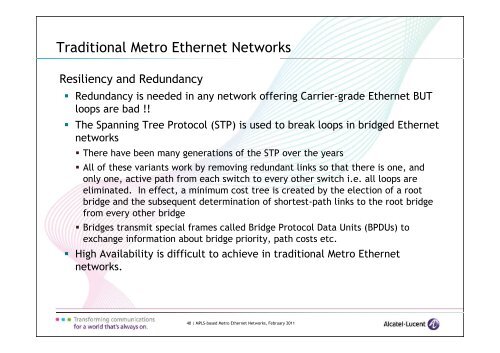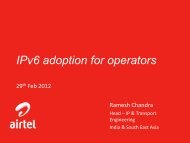APRICOT 2011 - MPLS-based Metro Ethernet Networks v1.0
APRICOT 2011 - MPLS-based Metro Ethernet Networks v1.0
APRICOT 2011 - MPLS-based Metro Ethernet Networks v1.0
Create successful ePaper yourself
Turn your PDF publications into a flip-book with our unique Google optimized e-Paper software.
Traditional <strong>Metro</strong> <strong>Ethernet</strong> <strong>Networks</strong><br />
Resiliency and Redundancy<br />
Redundancy is needed in any network offering Carrier-grade <strong>Ethernet</strong> BUT<br />
loops are bad !!<br />
The Spanning Tree Protocol (STP) is used to break loops in bridged <strong>Ethernet</strong><br />
networks<br />
There have been many generations of the STP over the years<br />
All of these variants work by removing redundant links so that there is one, and<br />
only one, active path from each switch to every other switch i.e. all loops are<br />
eliminated. In effect, a minimum cost tree is created by the election of a root<br />
bridge and the subsequent determination of shortest-path links to the root bridge<br />
from every other bridge<br />
Bridges transmit special frames called Bridge Protocol Data Units (BPDUs) to<br />
exchange information about bridge priority, path costs etc.<br />
High Availability is difficult to achieve in traditional <strong>Metro</strong> <strong>Ethernet</strong><br />
networks.<br />
40 | <strong>MPLS</strong>-<strong>based</strong> <strong>Metro</strong> <strong>Ethernet</strong> <strong>Networks</strong>, February <strong>2011</strong>













